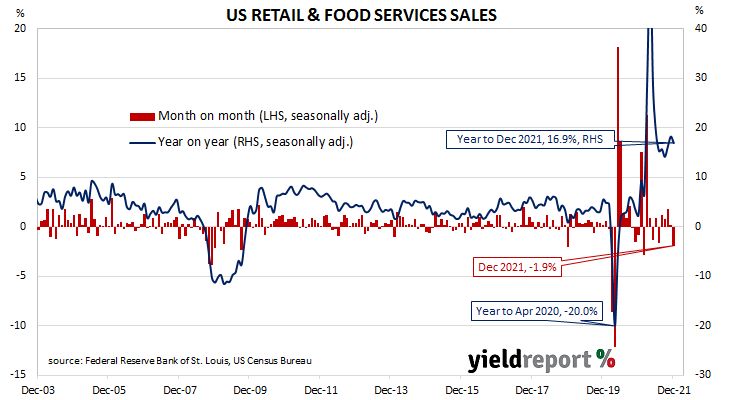Summary: US retail sales down 1.9% in December, fall greater than 0.1% decline expected; highest inflation in 40 years impacting consumer behaviour; ongoing congestion at US ports, Omicron hampering production, consumption “everywhere”; falls in nine of twelve retail categories; “Non-store” segment” the largest single influence, falls 8.7%.
US retail sales had been trending up since late 2015 but, commencing in late 2018, a series of weak or negative monthly results led to a drop-off in the annual growth rate below 2.0%. Growth rates then increased in trend terms through 2019 and into early 2020 until pandemic restrictions sent it into negative territory. A “v-shaped” recovery then took place which was followed by some short-term spikes as federal stimulus payments hit US households in the first and second quarters of 2021.
According to the latest “advance” sales numbers released by the US Census Bureau, total retail sales declined by 1.9% in December. The fall was greater than the 0.1% decline which had been generally expected and in contrast to November’s +0.2% after it was revised down from 0.3%. On an annual basis, the growth rate slowed from November’s revised figure of 18.2% to 16.9%.
“The data suggest the highest inflation in 40 years is impacting consumer behaviour and this may well extend into Q1, when the end of the child tax credits will also weigh,” said ANZ Head of Australian Economics David Plank.
US Treasury bond yields moved noticeably higher on the day. By the close of business, the 2-year Treasury yield had gained 7bps to 0.96%, the 10-year yield had added 9bps to 1.79% while the 30-year yield finished 8bps higher at 2.12%.
Plank noted supply shortages have not helped. He noted ongoing congestion at US ports while “Omicron is hampering production and consumption everywhere.”
Nine of the twelve categories recorded lower sales over the month. The “Non-store retailers” segment, provided the largest single influence on the overall result, falling by 8.7% for the month, although this segment still managed a 10.7% rise for the year.
The non-store segment includes vending machine sales, door-to-door sales and mail-order sales but nowadays this segment has become dominated by online sales. It now accounts for a little over 14% of all US retail sales and it has become the second largest segment after the vehicles and parts segment.



